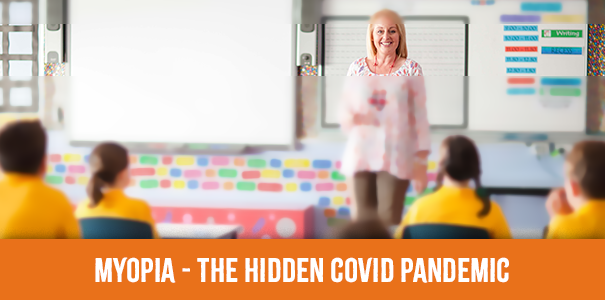Myopia – the hidden pandemic from COVID lockdowns

As the world emerges from an almost 18-month on/off lockdown period to battle the COVID-19 pandemic, concerns about the safety of vaccines rank highly in media reports.
Yet there are other hidden, but potentially long-term side-effects that are starting to emerge in school children – such as Myopia, or, short-sightedness.
Millions of children around the world have spent substantial time using remote learning methods following the closure of schools due to the COVID-19 pandemic. Longer exposure to screens on digital devices is having an effect on their sight, specifically the ability to see longer distances – such as the teacher or material displayed at distance in a classroom.
A new study published in one of the world’s leading medical journals has revealed a link between screen time and higher risk and severity of myopia in children and young adults. The authors examined more than 3,000 studies investigating smart device exposure and myopia in children and young adults aged between 3 months old and 33 years old.
After analysing and statistically combining the available studies, the authors revealed that high levels of smart device screen time, such as looking at a mobile phone, is associated with around a 30% higher risk of myopia and, when combined with excessive computer use, that risk rose to around 80%.
A school-based program by John Hopkins researchers gave thousands of students from Years 3-7 free screening and eyeglasses, found that students scored higher on reading and math tests. Those students who struggled the most academically before receiving glasses showed the greatest improvement.
But the academic improvements seen after one year were not sustained over two years. Researchers suspect “this could be a result of students wearing their glasses less over time, possibly due to losing or breaking them”.
To maintain the academic achievement, the researchers say in addition to providing the initial exams and glasses, school-based vision programs should develop stronger efforts to make sure children are wearing the glasses and to replace them if needed.
An alternate study was cautious about the screen time and myopia connection but noted: “As children continue to adopt digital devices at ever younger ages and their screen time increases, there is a pressing need for researchers to investigate the effects of these devices on eye health in diverse populations, and to use objective measures and clear and standardised categories of device exposure to better understand the role it might play in the escalating myopia epidemic.”
In summary, the change to digital technology learning for students must be monitored in the classroom to ensure that any divergence form expected learning levels be reviewed outside of the curriculum expectation and look at medical/health issues such as Myopia.
Sources
https://thenewdaily.com.au/life/wellbeing/2021/10/16/myopia-pandemic
https://www.sciencedaily.com/releases/2021/10/211007122131.htm
https://www.thelancet.com/journals/landig/article/PIIS2589-7500(21)00135-7/fulltext

